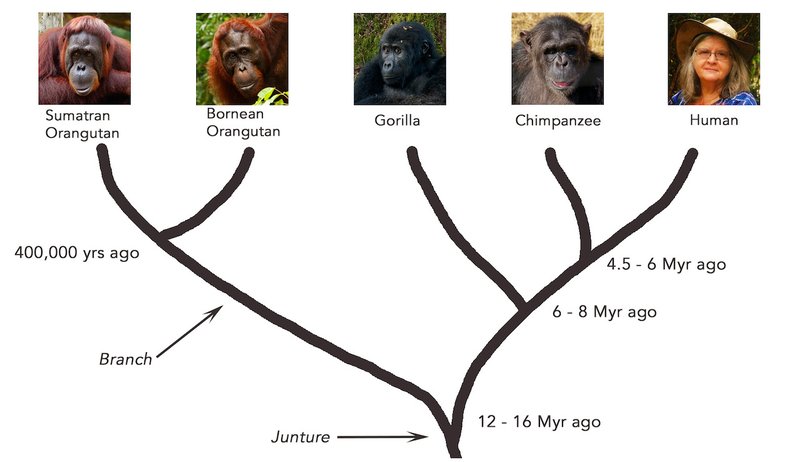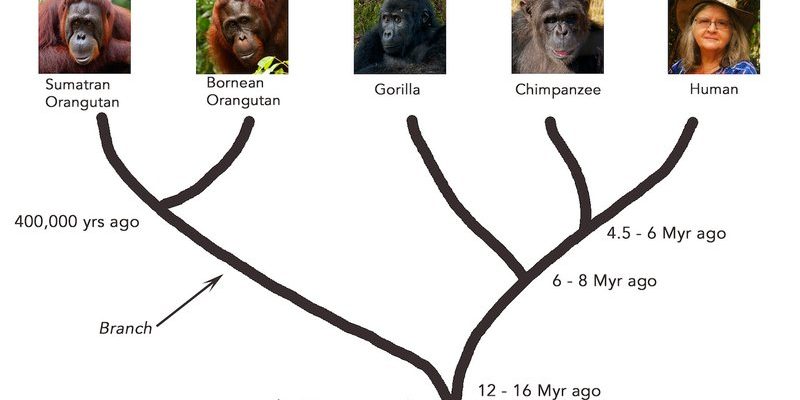
Orangutans are one of our closest living relatives, so exploring their past gives us insight not just into their lives but also into our own evolution. They’ve been around on this planet for millions of years, surviving through changing climates, shifting landscapes, and even the rise of human influence. When you dive into their history, you’re not just learning about a species—you’re uncovering a story of resilience, adaptation, and survival.
Where Did Orangutans Come From?
To start, it’s helpful to look at the family tree of primates. Orangutans belong to the great ape family, which includes gorillas, chimpanzees, and humans. This family branched off from a common ancestor over 14 million years ago. That ancestor didn’t look like any ape we know today, but it’s interesting to think about how all of these species share a distant connection.
As the story goes, orangutans began to evolve separately from other great apes. Around 13 million years ago, they started to develop distinctive traits that set them apart. For example, their long arms evolved for a life spent mostly in trees. This ability to swing from branch to branch made them excellent foragers, allowing them to reach fruits and leaves that many other animals couldn’t.
Over time, orangutans adapted to live in the rainforests of Southeast Asia, particularly on the islands of Borneo and Sumatra. These lush environments shaped their behavior and habits, allowing them to thrive in a place rich with food and shelter. It’s fascinating to think about how their surroundings played a significant role in their development.
The Unique Characteristics of Orangutans
Orangutans have several unique features that make them stand out. Their reddish-brown fur isn’t just for looks; it helps them blend in with the foliage of their forest homes. Their large, powerful arms allow them to navigate the treetops with ease. Honestly, watching them swing around is like witnessing nature’s acrobats in action!
Another interesting characteristic of orangutans is their social behavior. They’re generally solitary animals, unlike many other primates that live in groups. Male orangutans tend to roam alone, while females usually stay with their young. This solitary lifestyle has evolved as a way to find more food without competition. It’s almost like being an introvert in the animal world, preferring to have your own space while still raising a family.
Interestingly, orangutans are also known for their intelligence. They can use tools, such as sticks to extract insects from tree bark or leaves to help them drink water. This problem-solving ability highlights their cognitive skills, making them one of the smartest non-human primates. You might say they have a knack for thinking creatively, which helps them adapt to their environment.
The Impact of Climate Change
As we look at the evolutionary history of the orangutan, it’s crucial to mention one of the biggest threats they face today: climate change. As temperatures rise and rainfall patterns shift, orangutan habitats are changing dramatically. This can lead to food shortages, which in turn affects their ability to survive and reproduce.
Moreover, deforestation plays a significant role in this story. As humans expand into forested areas for agriculture and logging, orangutans lose their homes. Imagine being uprooted from a place you’ve lived for millions of years! The destruction of their habitats not only threatens their population but also disrupts the delicate ecosystem they support.
Conservation efforts are underway, but they’re like climbing an uphill mountain—challenging but essential. Organizations are working hard to protect the remaining rainforests, promote sustainable practices, and rehabilitate orphaned orangutans. It’s a race against time to preserve these incredible creatures and their homes.
The Cultural Significance of Orangutans
Orangutans aren’t just important for biodiversity; they also hold significant cultural value. In many indigenous cultures of Southeast Asia, orangutans are seen as a symbol of wisdom and connection to nature. Stories and folklore featuring these creatures highlight their intelligence and gentleness, reinforcing their role in the cultural heritage of the region.
However, the challenge lies in balancing this cultural appreciation with the pressing need for conservation. As more people come to understand the plight of the orangutan, there’s hope that awareness will lead to increased efforts in protecting these magnificent animals. Education plays a pivotal role here, as it inspires the next generation to care about wildlife and the environment.
Let’s not forget that the story of the orangutan is also a reflection of our own human journey. By caring for these creatures and their habitats, we’re making a commitment to protect not only their future but also our planet’s health.
Orangutans Today and the Future
Today, orangutans are classified as critically endangered. This means that their populations are at very serious risk of extinction. Current estimates suggest that there are only about 55,000 Bornean orangutans and around 13,600 Sumatran orangutans left in the wild. With numbers like these, it’s hard not to feel a sense of urgency.
The future of orangutans hangs in the balance. Conservationists are working tirelessly to create sanctuaries for rescued orangutans, while also advocating for stricter laws against poaching and habitat destruction. Every effort counts, and even small actions can contribute to their survival. If you’re wondering what you can do, consider supporting organizations that focus on wildlife conservation or spreading awareness about their plight.
Moving forward, society must work together—we cannot afford to ignore the connection between the fate of the orangutan and our responsibility as stewards of the Earth. By coming together to protect these remarkable creatures, we not only ensure their survival but also maintain the rich tapestry of life that shares our planet.
The evolutionary history of the orangutan isn’t just a story of survival; it’s a powerful reminder of the interconnectedness of all life on Earth. From their distant ancestors who roamed the forests millions of years ago to the challenges they face today, orangutans embody the resilience of nature.
By understanding their journey, we can appreciate their role in maintaining the delicate balance of their ecosystems and our responsibility to protect them. So, next time you hear about the orangutan, remember that they are not just animals; they are a symbol of both the beauty of evolution and the importance of conservation. Together, let’s ensure that their story continues for generations to come.

